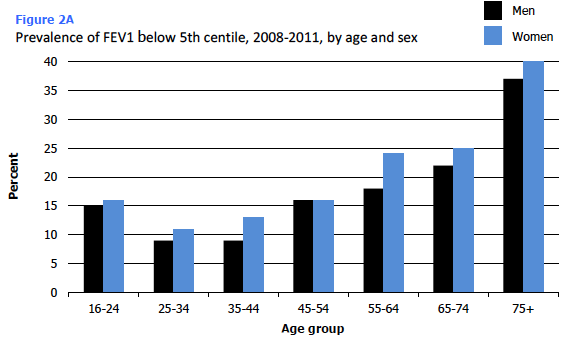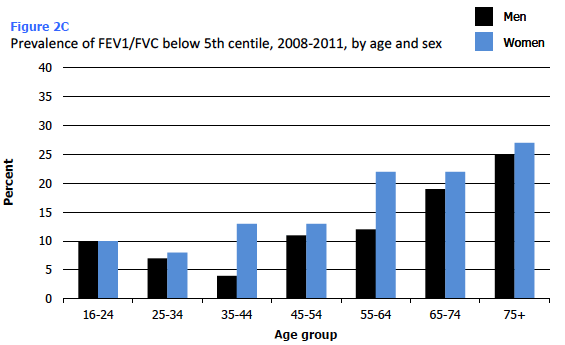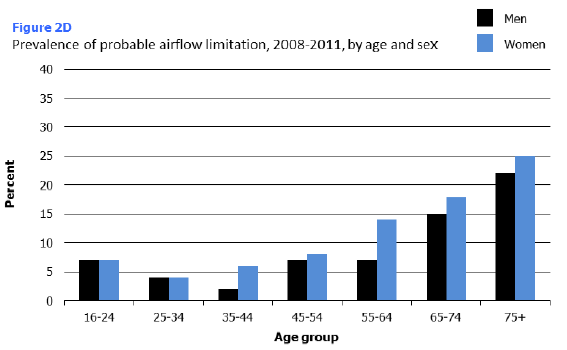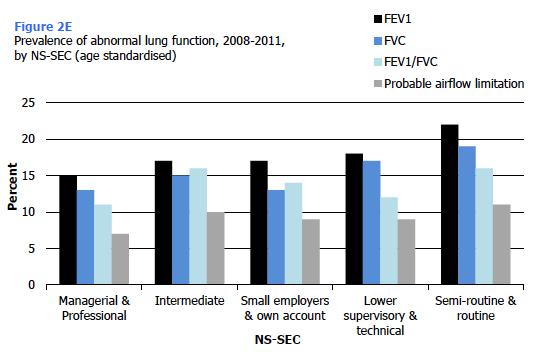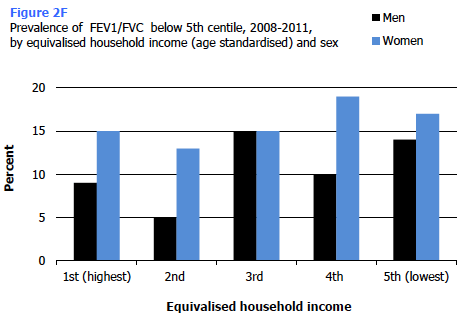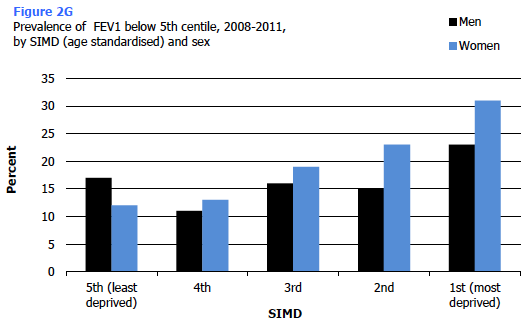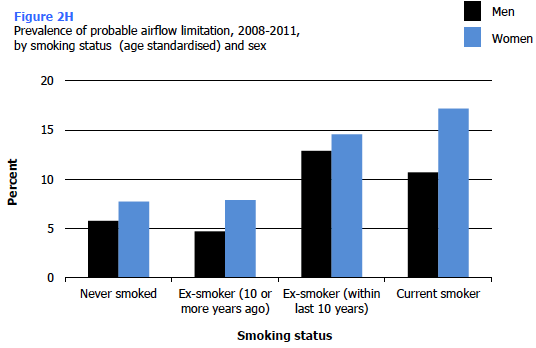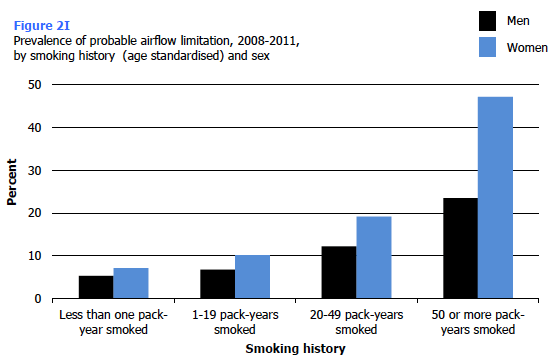Scottish Health Survey - topic report: lung function
This report presents data from objective measurement of lung function in adults, measured by portable spirometers, using data from the 2008-
2011 Scottish Health Surveys.
This document is part of a collection
2 Lung Function in Adults
Jennifer Mindell, Alison Moody, Catherine Bromley, Lisa Rutherford
Summary
- This chapter presents findings on adults' lung function, measured by spirometry, in the Scottish Health Survey (SHeS) 2008-2011. While the protocol and equipment used were the same as in earlier years of the survey, the method of presenting results has changed over time, so results cannot be compared with earlier years. Results are presented as the percentage of the predicted values expected for an individual of a given age, sex, and height, and how that compares with the distribution of values in a healthy (reference) population. As the all-ages reference equations used for the lung function results in SHeS 2008-2011 do not apply to members of non-white ethnic groups, analysis has been limited to participants from white ethnic groups, aged 16 years and over.
- The following data on lung function are presented: forced expiratory volume in one second (FEV1); forced vital capacity (FVC); and the ratio of these measurements (FEV1/FVC). Mean values of these three parameters are given as a percentage of the individual's predicted value. In addition, the proportions of participants whose results lie below the 5th centile[1] (the 'lower limit of normal' LLN) and below the 2.5th centile are also provided. Finally, the proportion of participants for whom both FEV1 and FEV1/FVC were below the 5th centile is shown, with these people deemed to have 'probable airflow limitation.' The SHeS did not use bronchodilators[2] prior to spirometry.
- FEV1 was at or above the 5th centile in 84% of men and 81% of women. The equivalent figures for FVC were 85% for men and 84% for women, and for FEV1/FVC were 89% and 84% respectively.
- Mean lung function was lower among older age groups (FEV1 of 79.8% of predicted for men aged 75+ and 85.1% of predicted for women). The proportion with abnormal lung function was also highest among older people. For example, 15% of men and 16% of women aged 16-24 had FEV1 below the 5th centile, increasing to 18-37% of men and to 24- 40% of women aged 55 and over.
- Mean FVC varied significantly by sex and was lowest for men (96.5% compared with 98.4% for women), and declined with age for men at a faster rate than for women. FEV1 did not differ by age, therefore mean FEV1/FVC was higher for men than women.
- The proportion falling below the 5th centile for the ratio FEV1/FVC, was higher among women (16%) than men (11%), though the pattern of increase by age was similar for both sexes.
- In general, poor lung function was higher among those in the lowest income households, living in the most deprived areas, or with a household reference person with a semi-routine/routine occupation.
- Lung function was considerably worse in current smokers than in people who had never smoked cigarettes regularly. Ex-smokers who had stopped smoking more than 10 years ago had similar lung function to those who never smoked, but more recent ex-smokers had similar results to current smokers. The amount smoked was also an important factor: lung function decreased as lifetime cigarette consumption ('pack-years, the number of packs smoked per day multiplied by the number of years smoked) increased.
- Seven percent of men and 10% of women had probable airflow limitation. The proportion with probable limitation increased sharply after middle age, from 2-7% of men and 4-8% of women aged 16-54 to 22% of men and 25% women aged 75 and over.
- Logistic regression showed that age and smoking history as measured by pack years (number of packs smoked per day multiplied by the number of years smoked) were each independently associated with probable airflow limitation in both men and women. Having no educational qualifications, and living in a more urban area were also each independently associated with probable airflow limitation in men but not in women.
2.1 Introduction
Chapter 8 of the 2010 Scottish Health Survey (SHeS) annual report presented findings on self-reported respiratory symptoms and doctor-diagnosed asthma in adults and children, using interview data on both symptoms and diagnoses.[3] This report presents data from objective measurement of lung function in adults, measured by portable spirometers. While the spirometers and protocols used in SHeS 2008-2011 were the same as in previous years, presentation and interpretation of spirometry data[4] now differ in a number of significant ways from earlier surveys, as is explained in more detail in Chapter 1 of this report. It is for these reasons that no comparisons between these results and earlier years of the survey are attempted in this chapter.
As outlined in Chapter 1, two direct measures of lung function were collected in the survey: forced expiratory volume in one second (FEV1) and forced vital capacity (FVC). In addition to these, this chapter presents two further results: the ratio of these measurements (FEV1/FVC), and the proportion of people deemed to have 'probable airflow limitation', based on both their FEV1 and their FEV1/FVC results. It should be borne in mind when interpreting the results that survey nurses did not use bronchodilators.[5]
2.1.1 Results presented in this chapter
For each participant, the best value for each parameter (FEV1 and FVC) has been used even if not from the same manoeuvre (instance of expiration); the ratio of FEV1/FVC was calculated from these best values. Information on whether participants were suffering from, or had recently experienced, a respiratory infection was not collected. In some cases, the nurse excluded participants because of such an illness but it was clear from nurse verbatim comments that some of those who attempted, but were not able to perform spirometry successfully, were affected by coughs, colds or 'flu-like' illnesses.
The 2009 updated Stanojevic All Age equations[6] were used to provide predicted values for the spirometry, adjusted for age, sex, and height. These equations apply only to white (caucasian) populations, so participants from non-white ethnic groups have been excluded from the analysis presented in this report. The predicted values for 80-year-olds were used for participants aged over 80.
Two sets of results have been presented: mean values and proportion of adults with probable airflow limitation. The mean values are of the actual value expressed, not in litres, but as the percentage of the predicted value for that individual, given their age, sex, and height. Where the participant refused the height measurement or it was not possible, the programme assigned an average value to that participant, given their sex (this occurred for 7% of adult participants with valid spirometry).
Results for the proportion of adults with probable airflow limitation are also presented. Defining thresholds for abnormality across a wide age-range,[6]6 does, however, give rise to problems, as discussed earlier in this report (see Section 1.2.2). To assess the prevalence of healthy or abnormal values, the results in this chapter were calculated as z-scores[7] to enable comparison of observations from different normal distributions, i.e. from different distributions around the predicted value for people of different sex, age and height. Z-scores indicate how many standard deviations (SD) a measurement is from its predicted value, and centile values can then be calculated. In a group of healthy individuals, the mean z-score equals 0 (with a standard deviation of 1), and 95% of healthy individuals should have a z-score between -1.96 and +1.96.
In addition to presenting, for each category of individuals, mean values as a percentage of their expected (predicted) values (Table 2.1), each table also includes results for: the proportion of adults with values falling on or above the 5th centile[8] (i.e. a z-score of -1.64 or above), who are very likely to have normal lung function; the proportion with values falling below the 5th centile for that parameter (i.e. a z-score less than -1.64), and the proportion falling below the 2.5th centile (i.e. a z-score of less than -1.96).[9] These last two categories are those likely and very likely, respectively, to have abnormal lung function.
An additional category of 'probable airflow limitation' was defined as both FEV1 and FEV1/FVC being below the 5th centile.[8][9]
2.2 Lung Function
2.2.1 Lung function by age and sex
In general, mean FEV1, mean FVC and mean FEV1/FVC each fell significantly with age and were much lower in those aged 75 and over than in other age groups. For example, among those aged 25 to 44 mean FEV1 ranged from 97.2-98.9% of predicted for men and 96.3-99.5% of predicted for women, falling to 79.8% and 85.1% of predicted respectively in those aged 75 and over.
Mean FVC and mean FEV1/FVC both differed by sex. FVC was higher in women with a mean of 98.4% of predicted compared with 96.5% in men. In addition, the fall in FVC in older age groups was much less pronounced in women than in men. FEV1/FVC was higher in men (mean 97.9% compared with 95.1% in women).
As summarised in Section 2.1.1, two separate measures of abnormally low lung function are presented in the tables. While the thresholds for defining what is abnormal are not universally agreed,[9] a lower limit of normal using the 5th centile is generally the more conventional measure and for this reason, this definition is focussed on in this report.
The proportion of adults with lung function below the 5th centile (lower limit of normal, LLN) was lowest among those aged 25-44, then rose with age thereafter, for each of the four measures of lung function (Figures 2A-2D). Prevalence of FEV1/FVC below the 5th centile differed by sex, and the pattern with age also differed in men and women, with substantially lower prevalence of abnormality in middle age in men than in women (Figure 2C).
Seven percent of men and 10% of women had probable airflow limitation, defined as being below the 5th centile for both FEV1 and FEV1/FVC (Table 2.1). Overall, probable airflow limitation increased with age, from 2-7% of men and 4-7% of women aged 16-54 to 22% of men and 25% of women aged 75 and over (Figure 2D).
Figures 2A - 2D, Table 2.1
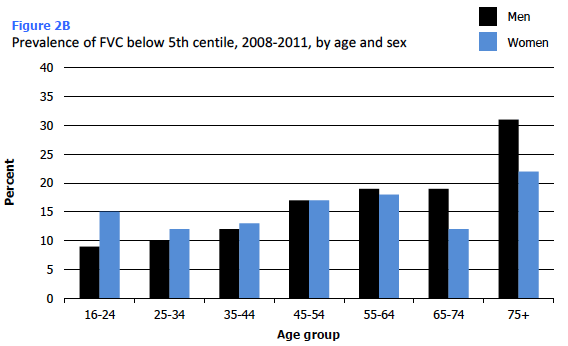
2.2.2 Lung function by socio-economic factors
NS-SEC of the household reference person
Mean FEV1, mean FVC and mean FEV1/FVC each varied by NS-SEC. A description ofNS-SECis provided in theglossaryto this report.Prevalence of lung function below the 5th centile varied by NS-SEC for each of the lung function parameters (Figure 2E). For example, 15% of participants in managerial and professional households had an FEV1 value below the 5th centile, rising to 22% of those in semi-routine and routine households. Five percent of men and 9% of women in managerial & professional households had probable airflow limitation. The equivalent figures for those in semi-routine and routine households were 9% and 13% respectively. Figure 2E, Table 2.2
Equivalised household income
The relationships between lung function and household income were more complex. A description ofequivalised household incomeis provided in theglossaryto this report.In general, for each of the four measures, lung function deteriorated as income quintile reduced. For example, FEV1 below the lower limits of normal increased from 14% of adults in the highest income quintile to 22% in the lowest. For both FEV1/FVC and probable airflow limitation, the pattern by income differed by sex, with greater variation in men than in women.
Scottish Index of Multiple Deprivation (SIMD)
Lung function varied by SIMD quintile in both men and women. Generally, the proportion of adults with abnormal lung function rose in line with increasing deprivation, with marked differences in the most deprived quintile (SIMD quintile 1). For example, 12-14% of adults in the three least deprived quintiles (SIMD quintiles 3, 4 and 5) had an FVC below the lower limit of normal compared with 22% in those living in Scotland's most deprived quintile. The relationship with deprivation on the three remaining measures differed by sex. For FEV1, there was a U-shaped distribution to the proportion of men with a value below the 5th centile (17% and 23% for those in the least and most quintiles respectively, compared with 11-16% among those in the middle three quintiles. In women, the increase in the proportion with a FEV1 value below the 5th centile was steeper and more linear (12% in the least deprived quintile compared with 31% in the most deprived quintile). A description ofSIMDis provided in theglossaryto this report.
2.2.3 Lung function by smoking status
Lung function varied substantially by smoking status with current smokers having the highest prevalence of abnormal lung function for each measure (Table 2.5). Those who had never smoked cigarettes regularly and ex-smokers who had given up 10 or more years ago had the best lung function (Figure 2H). Twelve percent of men and 16% of women who had never smoked had FEV1 below the 5th centile, compared with 25% of male and 30% of female current smokers. Those who had given up smoking more than 10 years ago had similar lung function to those who never smoked, and lung function of those who had given up more recently was similar to current smokers.
Another measure of smoking, 'pack-years', takes into account both duration and frequency of smoking, by multiplying the number of cigarettes per day smoked by the number of years a person was a smoker, and dividing by 20 to give a 'pack-year'. Those with less than a single 'pack-year' (including none) had the best lung function, with 5% of men and 7% of women having probable airflow limitation. This increased in a dose-response manner with increasing pack-years to 23% of men and 47% of women with 50 or more pack-years. It should be noted that relatively few women had smoked for 50 or more pack-years, so the estimate for women in this highest category is imprecise.
2.2.4 Factors associated with probable airflow limitation
Multivariable logistic regression was performed to examine the independent effect of a range of health and socio-economic factors associated with poor lung function (probable airflow limitation, defined as both FEV1 and FEV1/FVC below the 5th percentile of a healthy population).[10] Table 2.7 presents models of the risk factors associated with survey-defined probable airflow limitation, after adjustment for the other factors listed in the table.
All adults aged 16 years and over in white ethnic groups with valid spirometry were included in the models. Separate models were constructed for men and for women but any factor associated with probable airflow limitation in men or in women was included in the final model for both sexes, so that the two models would be the same. The final models made statistical adjustment for the complex survey design.
Since probable airflow limitation was rare in participants younger than 45, the three youngest age groups were combined as the reference category for age group. Individual and household-level socioeconomic variables included equivalised household income quintile and highest educational qualification. Two variables relating to area were also included: SIMD quintile, and a binary classification of rural/urban residence. The health factors considered were cigarette smoking status and number of cigarette pack-years (defined as the number of packs smoked per day multiplied by the number of years smoked) for smokers.[11] Further details on the categories for each of these variables are included in Table 2.7.
The risk factors indicate associations, not causes. Differences in risk are shown as odds ratios, the degree to which the odds of the key outcome increases or decreases relative to odds in the reference category. Odds ratios greater than 1 indicate an increased risk compared with the reference category; odds ratios less than 1 indicate a decreased risk. 95% confidence intervals are shown; odds are significantly different from the reference category if the limits of the confidence interval do not include 1.
For men age, smoking history (measured in pack years), educational attainment, equivalised household income and rural/urban classification were all significantly associated with probable airflow limitation the outcome. For women, probable airflow limitation was associated with age and smoking history measured in pack-years. The final models included the same variables for each sex.
Two different measures of smoking were tested in the model: whether a person smoked currently, had given up within the past 10 years, had given up longer ago or had never regularly smoked; and the number of daily cigarette packs (of 20 cigarettes) smoked multiplied by the number of years smoked. Using these categories, the lung function of ex-smokers who had stopped smoking more than 10 years ago was similar to that of people who had never smoked, while those who had stopped smoking more recently had lung function similar to current smokers.
When smoking history (pack-years) was accounted for, current cigarette smoking status was no longer significantly associated with probable airflow limitation. This is partly because there is a large overlap between the two ways of measuring smoking, and partly because of the two, the total amount smoked (as measured in pack-years) is a better predictor. Likewise, the association with equivalised household income was not significant once highest educational qualification was accounted for, since there is a strong correlation between income and education. The final models therefore included age, educational attainment, rural/urban residence, and smoking history measured in pack-years.
Holding all other factors equal, the odds of poor lung function increased with age for both men and women, and was around three times as high in those aged 75 and over as those aged 16-44 (odds ratios of 3.31 and 2.85 for men and women aged 75 and over respectively).
Smoking history, measured in pack-years, was also associated with probable airflow limitation in both sexes. The odds of poor lung function for both men and women increased in line with increased pack years. When compared with those who had smoked less than one pack-year (including none), the odds of men smoking at least 50 pack years having airflow limitation more than doubled (odds ratio of 2.49); for women, the odds quadrupled (odds ratio of 4.01).
The association between airflow limitation and educational attainment was significant for men but not for women. The odds of men with no qualifications having probable airflow limitation were more than double that for those educated to degree level or above (odds ratio of 2.72).
For men, the urbanity of the area they lived in was also significantly associated with having probable airflow limitation. The odds of men residing in more urban areas (defined as primary cities or other urban areas with populations over 10,000) having probable airways obstruction were double those for men in more rural areas (odds ratio of 2.00). Table 2.7
Lung function was worse for participants with asthma (Table 2A) but neither excluding people with asthma or longstanding respiratory illness from the model nor including these as explanatory variables in the model affected the results given above and in Table 2.7.[10]
Table 2A Associations between self-reported respiratory disease and probable airflow limitationa
| Odds ratio | (95% Confidence interval) | |
|---|---|---|
| Men | ||
| Any respiratory condition | 2.9 | (1.9-4.4) |
| Asthma | 2.5 | (1.5-4.4) |
| Women | ||
| Any respiratory condition | 1.9 | (1.3-2.8) |
| Asthma | 1.5 | (1.0-2.4) |
a Adjusted for age, education, area (rural vs city/urban), and smoking (pack-years).
2.2.5 Comparison with Health Survey for England (HSE) results
Comparisons with the HSE 2010 data should be made with caution for three reasons. Different spirometers were used in the two surveys; HSE excluded results from poor quality blows but no formal quality assessments were possible in SHeS; and the exclusion criteria for spirometry were less extensive in SHeS than in HSE.
For each of the four sets of lung function results presented throughout this chapter, the proportion of men and women with levels below the 5th centile were higher in Scotland than in England. This difference was particularly apparent among adults aged 75 and over (Table 2B).
Table 2B Comparison of SHeS 2008-2011 results with HSE 2010 results: prevalence of lung function below the 5th centile
| Abbreviation | Aged 35-44 % |
Aged 75+ % |
All aged 16+ % |
|||
|---|---|---|---|---|---|---|
| SHeS | HSE | SHeS | HSE | SHeS | HSE | |
| Men | ||||||
| FVC | 12 | 10 | 31 | 17 | 15 | 12 |
| FEV1 | 9 | 15 | 37 | 21 | 16 | 15 |
| FEV1 / FVC | 4 | 4 | 25 | 20 | 11 | 8 |
| Probable airflow limitation | 2 | 2 | 22 | 13 | 7 | 6 |
| Women | ||||||
| FVC | 13 | 8 | 22 | 16 | 16 | 9 |
| FEV1 | 13 | 12 | 40 | 34 | 19 | 16 |
| FEV1 / FVC | 13 | 10 | 27 | 13 | 16 | 8 |
| Probable airflow limitation | 6 | 3 | 25 | 13 | 10 | 6 |
2.3 Discussion
2.3.1 Limitations in interpreting the results
Since information on current or recent acute respiratory infections was not collected by the nurse, some participants who were affected by these may have been unable to provide adequate quality blows for inclusion and/or to demonstrate their usual lung function.
Additionally, for practical reasons[5] bronchodilators were not given by the survey nurse, so post-bronchodilator spirometry results are not available. The extent of reversibility of airflow limitation or whether it was fixed obstruction cannot therefore be determined. The 2010 updated National Institute for Clinical Excellence (NICE) guidance recommended that reversibility[12] is not specifically tested. It also noted that the results are often unhelpful as the extent of reversibility is seldom large enough to rule out COPD or be diagnostic of asthma. The NICE guidance did, however, recommend post-bronchodilator spirometry for diagnosis and assessment of severity of obstructive airways diseases.[12] For both these reasons, abnormal values are therefore probably overestimated. Participants were, however, not asked to refrain from taking medications prior to testing, so these results represent usual (medicated) performance, not unmedicated.
Other factors may have led to an underestimation of the prevalence of poor lung function, if some of those with disease did not attempt spirometry. However, people with diagnosed chronic respiratory disease are probably more familiar with spirometry so may be better at producing adequate blows. In HSE 2010, the presence of diagnosed disease did not adversely affect successful spirometry although fewer older current smokers attempted spirometry.
The European Respiratory Society (ERS) Global Lungs Initiative (GLI) has recently developed reference equations for non-white ethnic groups.[13][14][15][16] Future analyses of the SHeS 2008-2011 data could thus incorporate the data for the SHeS participants excluded from the analysis presented in this report. In total, data for 42 males and 57 females were excluded from the analysis.
2.3.2 SHeS 2008 - 2011 findings
These results have been compared only with contemporary results from England. Although the spirometers and protocols used in SHeS 2008-2011 were the same as those used in earlier years in the series, the data were not directly comparable with previous years' results. Other comparisons with previous years of SHeS or HSE, or with other studies have therefore not been made as different prediction equations have been used to interpret the results and different ways of analysing the results have been used.
In both men and women, lung function varied by NS-SEC of the household reference person, by equivalised income, and by SIMD quintile. Generally, the proportion with abnormal lung function rose as affluence and deprivation decreased. Each measure of lung function was worst in the least affluent group; this was particularly noticeable by SIMD quintile.
Greater prevalence of asthma in young adults may explain the J-shaped relationship between age and some lung function parameters, as post-bronchodilator spirometry was not used. Survey participants reporting asthma or any chronic respiratory disease had raised odds of spirometry-defined probable airflow limitation.
The poorer lung function in Scotland relative to England could be artefact due to different spirometers and exclusion of poor quality blows in HSE. It could, however, be due to greater exposure to active and passive smoking. The proportion of adults in Scotland who smoked 20 or more pack-years was higher than the proportion in England (Table 2C). Smoking history that includes lifetime consumption, not just current smoking status, is one of the major predictors of lung function.[17]
Mortality from other smoking-related diseases, particularly circulatory diseases and cancers, is much higher in Scotland,[18] so fewer smokers may survive long enough to develop COPD. As men have succumbed to cardiovascular diseases at younger ages than women, particularly among smokers, the heavier male smokers may have been less likely to survive long enough to develop COPD. Thus, as cardiovascular disease rates fall in Scotland,[18] COPD prevalence and mortality could increase until a younger cohort of non-smokers or ex-smokers ages. It is also relevant to note that airways obstruction is a major clinical indicator of mortality risk.[19]
Table 2C Comparison of SHeS 2008-2011 and HSE 2010 participants' smoking history a
| Pack-years smoked | SHeS | HSE | ||
|---|---|---|---|---|
| Prevalence | (95% CI) | Prevalence | (95% CI) | |
| % | % | % | % | |
| Men | ||||
| Less than 1 pack-year | 56.7 | 53.7-59.7 | 54.5 | 51.5-57.4 |
| 1-19 pack-years | 23.9b | 21.6-26.5 | 31.5 | 28.9-34.2 |
| 20-49 pack-years | 13.5c | 11.9-15.4 | 10.4 | 9.0-11.9 |
| 50 or more pack-years | 5.8c | 4.8-7.0 | 3.7 | 2.9-4.7 |
| Women | ||||
| Less than 1 pack-year | 57.9 | 55.5-60.1 | 59.6 | 57.2-62.0 |
| 1-19 pack-years | 26.1 | 24.1-28.2 | 28.1 | 26.0-30.2 |
| 20-49 pack-years | 13.5 | 12.0-15.0 | 10.8 | 9.4-12.3 |
| 50 or more pack-years | 2.6 | 2.0-3.4 | 1.5 | 1.1-2.1 |
a Figures are for participants who provided valid lung function data, weighted by the nurse visit weight.
b Prevalence among SHeS 2008-2011 participants was significantly lower than among HSE 2010 participants.
c Prevalence among SHeS 2008-2011 participants was significantly higher than among HSE 2010 participants.
The odds of having existing disease can often be higher in ex-smokers, who include many who stopped smoking because of developing smoking-related diseases, than in current smokers, who include the up to 50% of regular smokers who do not die prematurely from their smoking. It was therefore encouraging to see that ex-smokers had lung function only a little worse than those who had never smoked. This finding, that stopping smoking appears to prevent further deterioration in lung function, provides further support for action to encourage smokers to quit.
The logistic regression showed interesting differences in lung function by sex. For men only, low educational attainment was a significant predictor of probable obstructed airways. Bearing in mind that the cohort most likely to have obstructed airways are the oldest participants, who would have reached working age in the 1940s and 1950s, historical patterns of work may be more relevant than contemporary ones.[20] Thus men with low or no qualifications were much more likely than women with similar education to be exposed long-term to outdoor and/or workplace air pollution. Also living in a city/urban location was a significant risk factor for men only, which may be related to sex differences in response to pollution exposure. Some studies have found that long-term exposure to small airborne particles (PM2.5) concentrated in cities and around busier roads, carries a greater risk of mortality for men than women, though the reason for this difference is not clear.[21] The number of pack-years smoked was a greater risk factor for women than men, which may reflect different social patterning of smoking between the sexes: historically, smoking was very common among men of all socio-economic groups for many years but it became common in women later, so was more socially patterned sooner in the smoking epidemic.
2.3.3 Quality and Outcomes Framework
COPD is one of the conditions included in the Quality and Outcomes Framework (QOF) of the General Medical Services contract, introduced in 2004.[22] Thisprovides incentives to deliver high quality care. This national dataset has, however, an important disadvantage as only aggregated data are available, so it is not possible to compare data by age, socioeconomic position or other factors.
QOF data on COPD are briefly reviewed in theprimary care data section of QOF.[23] Since April 2006, QOF definitions have allowed patients to be on both asthma and COPD registers where they have some reversibility of their airways disease. The introduction of the QOF may have affected the recording of COPD in primary care. As a wide range of diagnoses (using their respective read codes)[24] are included in the definition of COPD used to calculate QOF indicators, GPs may now be more careful not to use these codes unless they specifically want to include a patient on the COPD register.
The QOF registers for Scotland recorded around 2% of adult patients on the register for COPD during the survey period (from 1.9% in 2008-2009 to 2.1% in 2011-2012). Equivalent figures for asthma were around 6% of adults (5.7% in 2008-2009, 6.0% in 2011-2012). Depending on the amount of overlap between asthma and COPD, this indicates between 6% and 8% of Scottish patients listed on one or both registers, compared with 9% (with a 95% confidence interval of 7.9% to 10.1%) of adults with probably airflow obstruction as estimated through the Scottish Health Survey.
2.4 Conclusions
Expected values of lung function vary with age, sex, height and ethnicity. However, lung function in white residents of Scotland in 2008-2011 varied with age, NS-SEC, SIMD, and household income, even when measured using parameters that account for age, sex, and height. Older people and those from more deprived circumstances were more likely to have poor function and probable airflow limitation.
As expected, smoking was closely related to lung function. The best lung function was found among never smokers and those who stopped more than 10 years previously. Not surprisingly, some measures of lung function were worse among recent ex-smokers than current smokers, because a higher proportion of ex-smokers will have stopped smoking because of existing respiratory or circulatory disease. However, pack-years, a measure that combines duration of smoking and daily cigarette consumption, was most closely associated with poor lung function, with worse lung function among those with higher pack-years of smoking. The two important messages thus continue to be to advise non-smokers to remain non-smokers, and to support existing smokers to stop smoking as soon as possible, to limit the total pack-years they accrue.
Contact
Email: Julie Landsberg
There is a problem
Thanks for your feedback
